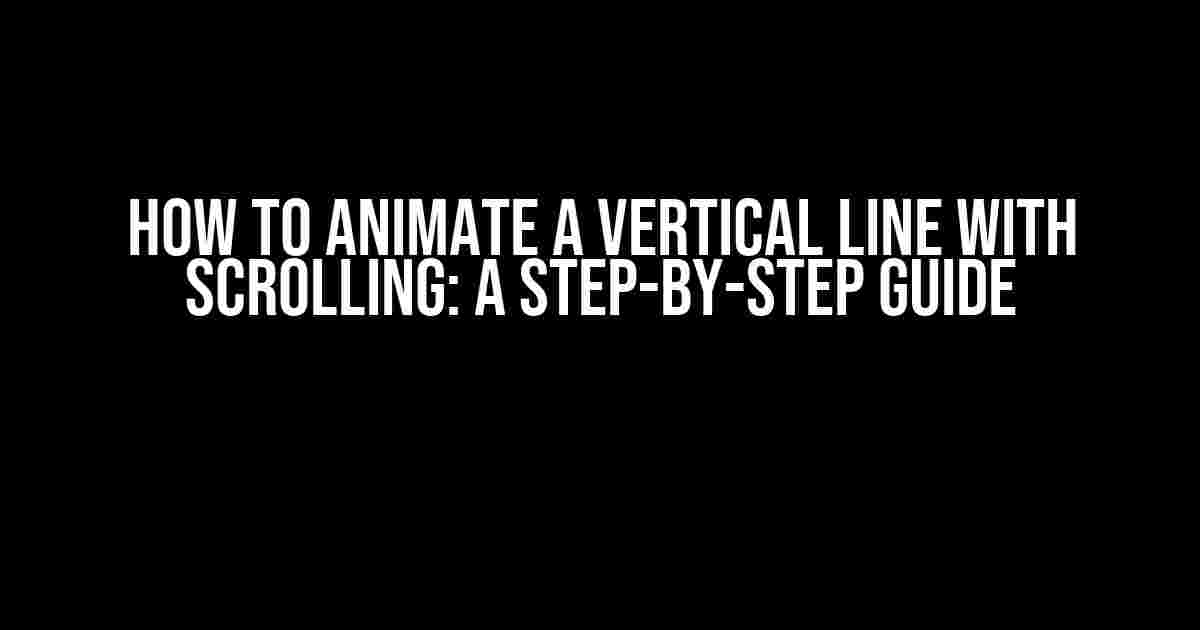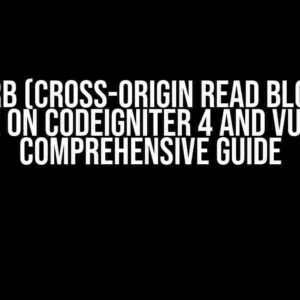Are you tired of static designs that fail to capture the user’s attention? Want to add some dynamic flair to your website or application? Look no further! In this article, we’ll show you how to animate a vertical line that responds to scrolling, creating an engaging and interactive experience for your visitors.
What You’ll Need
To follow along, you’ll need:
- A basic understanding of HTML, CSS, and JavaScript
- A code editor or IDE of your choice
- A browser that supports modern web technologies (Google Chrome, Mozilla Firefox, etc.)
The Concept Behind the Animation
Before we dive into the code, let’s discuss the concept behind the animation. We’ll create a vertical line that:
- starts from the top of the viewport (initially hidden)
- grows as the user scrolls down the page
- stops growing when it reaches a specific point on the page (e.g., a section or a div)
- remains stationary as the user continues scrolling
The HTML Structure
Create a new HTML file and add the following structure:
<div class="container"> <div class="vertical-line"></div> <!-- Add your content here --> <section class="scroll-target">Target section</section> </div>
This structure consists of:
.container: The outer container that wraps our vertical line and content..vertical-line: The element that will be animated..scroll-target: The section that serves as the stopping point for our animation.
The CSS Styles
Add the following CSS styles to your HTML file:
These styles:
- position the container relatively
- position the vertical line absolutely, setting its initial height to 0
- set the stopping point for our animation using the
.scroll-targetsection
The JavaScript Magic
Add the following JavaScript code to your HTML file:
<script>
const verticalLine = document.querySelector('.vertical-line');
const scrollTarget = document.querySelector('.scroll-target');
const windowHeight = window.innerHeight;
let scrollPosition = 0;
let animationTriggered = false;
window.addEventListener('scroll', () => {
scrollPosition = window.scrollY;
if (scrollPosition >= scrollTarget.offsetTop - windowHeight && !animationTriggered) {
animationTriggered = true;
// Animate the vertical line
verticalLine.style.height = `${scrollPosition - (scrollTarget.offsetTop - windowHeight)}px`;
}
});
</script>
This script:
- selects the vertical line and scroll target elements using
document.querySelector - sets the initial window height and scroll position
- adds a scroll event listener to the window
- checks if the scroll position has reached the stopping point (defined by the
.scroll-targetsection) - triggers the animation by setting the vertical line’s height based on the scroll position
Putting it All Together
Save your HTML file and open it in your browser. Scroll down the page to see the vertical line animate as you reach the stopping point. Adjust the styles and script to customize the animation to your liking.
| Property | Description |
|---|---|
.scroll-target‘s margin-top |
Adjust this value to change the stopping point for the animation. |
.vertical-line‘s height |
Modify this value to change the animation’s speed and duration. |
windowHeight |
Update this value to accommodate different screen sizes and orientations. |
Troubleshooting and Optimization
If you encounter any issues or want to further optimize the animation, consider the following:
- Check for any conflicting styles or scripts that might interfere with the animation.
- Use a debounce function to reduce the number of scroll events triggered.
- Optimize the animation for mobile devices and different screen sizes.
- Experiment with different easing functions to create a more natural animation curve.
Conclusion
You’ve successfully animated a vertical line that responds to scrolling! This effect can be used in a variety of creative ways to enhance user engagement and interaction. Remember to experiment with different styles and scripts to make the animation your own.
Happy coding, and don’t forget to share your creations with the world!
Here is the FAQ about “How to animate vertical line with scrolling”:
Frequently Asked Question
Are you tired of static vertical lines on your website? Want to know the secret to animating them with scrolling? Look no further! Here are the top 5 FAQs about animating vertical lines with scrolling:
What is the basic concept behind animating a vertical line with scrolling?
The basic concept is to use JavaScript to track the user’s scroll position and update the vertical line’s position accordingly. You can use libraries like jQuery or vanilla JavaScript to achieve this. The idea is to create an illusion of movement by updating the line’s position and color as the user scrolls.
How do I get the vertical line to move smoothly with scrolling?
To get a smooth animation, you’ll need to use a technique called “debouncing”. This involves delaying the animation by a few milliseconds to ensure it doesn’t happen too frequently, causing a jerky effect. You can use libraries like Lodash or underscore to debounce your animation function.
What if I want to animate multiple vertical lines with scrolling?
No problem! You can simply target multiple elements with the same class or ID and animate them together. Use JavaScript to loop through the elements and apply the animation to each one. You can also use CSS to style each line differently, creating a unique effect.
How can I customize the animation to fit my website’s style?
Customization is where the magic happens! You can tailor the animation to your website’s style by adjusting the animation speed, direction, and color. Use CSS to style the vertical line, and JavaScript to control the animation. You can also add additional effects, like fade-ins or fade-outs, to create a unique experience.
What if I want to animate the vertical line on mobile devices too?
Mobile devices can be a bit trickier, but don’t worry! You can use mobile-specific CSS media queries to adapt the animation to smaller screen sizes. You may need to adjust the animation speed and direction to accommodate touchscreen scrolling. Test your animation on different devices to ensure a seamless experience.


